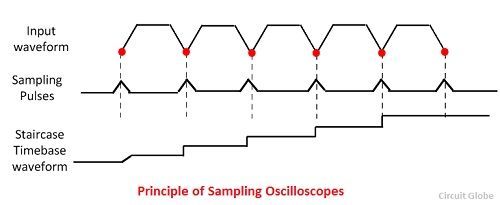Definition: The sampling oscilloscope is a special type of digital sampling oscilloscope which is used to examine a very fast signal. In other words, The sampling oscilloscope receives various electrical signal and then togetherly display the signals on the screen.
It works on the principle of stroboscopic light in which sample is taken at different portions of the waveform, over successive cycles, and then the total picture is stretched, amplified by relatively low bandwidth amplifiers, and display as the continuous wave on the screen.
The advantage of the sampling oscilloscope is that it can measure the very high-speed event with the help of the instrument having lower bandwidth. The disadvantage of the oscilloscope is are that it can only measure the repetitive or continuous signal. The frequency range of the oscilloscopes depends on their design.
The sampling techniques of the oscilloscope convert the input signal into the low-frequency domain. The low-frequency signal has a highly efficient domain. The sampling oscilloscopes in not used for displaying the transient signals.
Block Diagram of Sampling Oscilloscope
The block diagram of the sampling scope is shown in the figure below. The input signal is applied to the delay line where the signal is delayed. The signal delay means the precise time difference develops between the input and output signal.
The output obtains from the delay line passes to the diode sampling gate. The sampled signal received from the diode gate stores in the capacitor. Then it is fed to the amplifier for amplification and then given to the vertical axis of the display screen.
The single feedback is used from the amplifier to the diode gate. The feedback shows that the voltage stored on the capacitor increases only by the change in internal signal between each sample.
The staircase waveform is shown in the figure below. The waveform shows that it is reset after several numbers of steps. Thus, more than 1000 points are used on the screen for creating the waveform. The staircase waveform is used in the cathode ray tube. It is used for removing the spot on the screen.
 Delayed Sweep in sampling Oscilloscope
Delayed Sweep in sampling Oscilloscope
It is a technique of adding a time between the starting and the triggering point of the scope sweep. It increases the flexibility of the instrument. By the help of the delayed sweep oscilloscope, it is possible to amplify the undelayed signal. It is also helpful in many other applications like for measuring the rise time of the waveform or for measuring their pulse time modulation.

